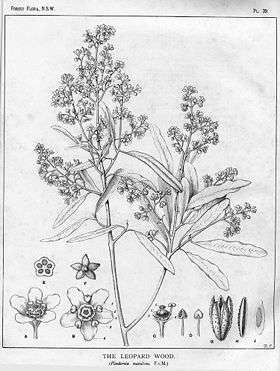Flindersia maculosa
| Leopardwood | |
|---|---|
 | |
| Flindersia maculosa | |
| Scientific classification | |
| Kingdom: | Plantae |
| (unranked): | Angiosperms |
| (unranked): | Eudicots |
| (unranked): | Rosids |
| Order: | Sapindales |
| Family: | Rutaceae |
| Genus: | Flindersia |
| Species: | F. maculosa |
| Binomial name | |
| Flindersia maculosa (Lindl.) Benth. | |
| Synonyms | |
|
* Elaeodendron maculosum Lindl. | |
Flindersia maculosa is a tree in the citrus family. It is found in arid and semi arid areas in New South Wales and Queensland, Australia. Because of the spotted bark, it is known as the leopardwood or leopard tree.
The habitat is stony hills and sand plains of the warm semi-arid zone of the Australian continent. It can grow in areas with an annual average rainfall of less than 250 mm, such as at Mutawintji National Park.
Description
An elegant small tree, up to 15 metres tall, but it usually grows to be around 6–10 meters tall. The bark sheds irregularly resulting in a mottled trunk. Leaves are opposite, small and narrow. This gives the foliage a wispy appearance. Leaves 10 to 80 mm long, and 2.5 to 10 mm wide.
Small cream flowers form around November. The fruit is a spiky woody capsule 2.5 cm long, which opens to release the seeds. Seeds are around 1.8 cm long with a thin winged membrane on both ends.
Uses
In times of drought, it has been used as a fodder tree.[1]
The wood of the tree is sometimes used to construct fence posts and pick handles.[2]
Nectar from the buds, and gum from the bark has been used to make a sweet drink.[3] The drink from the gum has been used as a remedy for diarrhea.[4] Being drought resistant and attractive, the Leopardwood is an ornamental tree for drier areas.
Ecology
Larvae of the moth Opodiphthera astrophela feed on the leopardwood tree.[5] An unidentified beetle in the Anilara genus can cause serious damage to the leopardwood tree.[6] The mistletoe Amyema lucasii grows on the Leopardwood tree.[7]

References
- ↑ "Fodder harvesting" (PDF).
- ↑ Resources, jurisdiction=Commonwealth of Australia; corporateName=Department of the Environment and Water. "Species Bank". www.environment.gov.au.
- ↑ "Bush foods: Talking about plants".
- ↑ "Native Australian Plants with Medicinal Uses".
- ↑ "Opodiphthera astrophela (Walker, 1855)". Archived from the original on 2005-07-18.
- ↑ Trevor J. Hawkeswood. "Review of the biology of the genus Anilara Saunders, 1868 (Coleoptera: Buprestidae)" (PDF). Archived from the original (PDF) on 2011-07-08.
- ↑ gluetext.com
- "Flindersia maculosa". PlantNET - NSW Flora Online. Retrieved 2009-08-01.